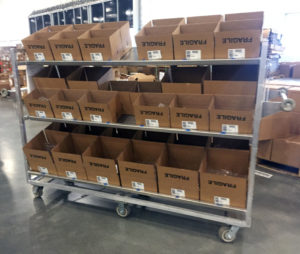Warehouse picking carts can be integrated into any warehouse or backroom operation to serve as a faster method for picking, stocking or transporting inventory. They are also a great way to utilize unused space and make maneuvering in confined spaces, like aisles, easier.
Inventory Characteristics to Evaluate
What items are you storing? What are their weight, shape, and size?
It’s very important that your warehouse picking carts can adequately house and transport your products. Most picking carts have a capacity between 1,200 lbs. and 3,600 lbs. and, depending on the number of shelves, have an average clearance between 11” and 17”. It’s important to keep this in mind while searching for a picking cart if your products are heavier and/or larger.
If you require carts to transport multiple SKUs at once, consider ones with multiple shelf levels. These are often used in retail and food and beverage operations. This will add more storage density per cart and provide for faster product accessibility.
How do you want to store and pick these items? How will your inventory need to be accessed? Do you have high or low product circulation?
In addition to having the ability to transport your items, carts must also provide the proper accessibility for your application. This is an important element to consider because it can speed up the rate of which things are shipped.
Open frame picking carts allow access to products from all four sides. This option provides the best product accessibility and can benefit operations with high product circulation. Two-sided carts allow access from both the long sides of the cart. Three-sided carts only allow products to enter and exit from one side, providing the least accessibility but safeguards inventory to prevent damage or spillage.
As you’ll read about further in this article, warehouse picking carts can also be outfitted with compartments, typically via bins, to organize SKUs or distinguish between shipments.

